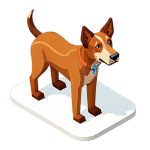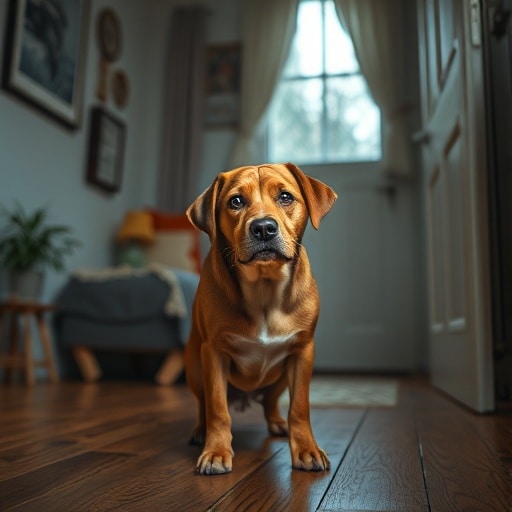Dog Anxiety Symptoms Checklist: Is Your Pet Trying to Tell You Something?
What is Dog Anxiety: Definition, Causes, and Types
Just like humans, dogs can experience anxiety. It's more than just a fleeting moment of unease; it's a persistent state of worry that can significantly impact their well-being. Dog anxiety is a complex issue with various causes, ranging from genetics and past traumas to environmental factors. Understanding the different types of anxiety is the first step in helping your furry friend.
- Generalized Anxiety: This is a persistent state of worry, not tied to any specific trigger.
- Separation Anxiety: Triggered by being left alone or separated from their owners.
- Social Anxiety: Occurs in social situations, like meeting new people or interacting with other dogs.
- Fear-Related Anxiety: Caused by specific triggers like loud noises (thunder, fireworks), vet visits, or car rides.
Identifying General Dog Anxiety Symptoms
Anxiety manifests differently in each dog. Some symptoms are subtle, while others are more pronounced. Recognizing these signs early can prevent the anxiety from escalating.
- Changes in Body Language: Look for a tucked tail, flattened ears, trembling, or excessive panting.
- Vocalization: Excessive barking, whining, or howling.
- Avoidance: Hiding, cowering, or trying to escape situations.
- Restlessness: Pacing, inability to settle down, or constant shifting of position.
Recognizing Dog Separation Anxiety Symptoms
Separation anxiety is a common issue for dogs. It's triggered when they are left alone or separated from their owners. The symptoms can be distressing for both the dog and the owner.
- Destructive Behavior: Chewing, scratching, or destroying furniture, doors, or personal items.
- Urination and Defecation: Accidents in the house, even if the dog is house-trained.
- Excessive Vocalization: Barking, howling, or whining that persists even after the owner has left.
- Attempting to Escape: Trying to get out of the house or confinement area.
See also: Effective Strategies on How to Deal with Severe Separation anxiety in Dogs
Common Dog Anxiety Triggers: What Makes Your Dog Anxious?
Identifying the triggers for your dog's anxiety is crucial for managing and preventing anxious episodes. Triggers can be environmental, social, or related to specific experiences.
- Loud Noises: Thunderstorms, fireworks, construction sounds.
- Strangers: Unfamiliar people entering the home or approaching on walks.
- Other Animals: Interactions with unfamiliar dogs or cats.
- Confinement: Being left alone in a crate, room, or car.
- Changes in Routine: New schedules, moving to a new home, or the absence of a family member.
- Vet Visits: The sights, smells, and handling at the vet's office.
Dog Anxiety Symptoms Checklist: A Comprehensive Guide
Use this checklist to assess your dog's behavior and identify potential anxiety symptoms.
- Body Language: ☐ Tucked tail ☐ Flattened ears ☐ Trembling ☐ Excessive panting ☐ Lip licking ☐ Yawning
- Vocalization: ☐ Excessive barking ☐ Whining ☐ Howling
- Avoidance: ☐ Hiding ☐ Cowering ☐ Trying to escape
- Restlessness: ☐ Pacing ☐ Inability to settle ☐ Constant shifting
- Destructive Behavior: ☐ Chewing ☐ Scratching ☐ Destroying items
- House Soiling: ☐ Urination ☐ Defecation
- Appetite Changes: ☐ Loss of appetite ☐ Increased appetite
- Sleep Pattern Changes: ☐ Increased sleeping ☐ Decreased sleeping ☐ Restless sleep
- Compulsive Behaviors: ☐ Excessive licking ☐ Tail chasing ☐ Pacing
If you checked several of these symptoms, it's important to consult with a veterinarian or a certified dog behaviorist to determine the underlying cause and develop a treatment plan.
Subtle Signs of Anxiety in Dogs: What to Look For?
Sometimes, anxiety in dogs manifests in subtle ways that can easily be overlooked. Paying close attention to these subtle signs can help you address the issue before it escalates.
- Lip Licking: Licking the lips when no food is present.
- Yawning: Yawning when not tired.
- Whale Eye: Showing the whites of the eyes.
- Stiff Body Posture: Holding the body in a tense or rigid way.
- Panting: Panting excessively when not hot or after exercise.
Behavioral Changes as Indicators of Anxiety
Changes in your dog's usual behavior can be a significant indicator of anxiety. These changes can affect their interactions with you, other people, and their environment.
- Increased Irritability: Snapping or growling more easily.
- Withdrawal: Becoming less social and less interested in interacting.
- Clinginess: Becoming excessively attached and following you everywhere.
- Changes in Playfulness: Showing less interest in playing or becoming overly excited during play.
Physical Dog Anxiety Symptoms: Health Implications
Anxiety can have physical health implications for dogs. Chronic stress can weaken their immune system and lead to various health problems.
- Gastrointestinal Issues: Vomiting, diarrhea, or constipation.
- Skin Problems: Excessive licking can lead to skin irritations or hot spots.
- Appetite Changes: Loss of appetite or increased appetite.
- Weight Loss or Gain: Due to changes in eating habits.
- Weakened Immune System: Making them more susceptible to illness.
Diagnosing Dog Anxiety: When to Consult a Vet?
If you suspect your dog is suffering from anxiety, it's essential to consult with a veterinarian. A vet can rule out any underlying medical conditions that may be causing the symptoms and provide a proper diagnosis.
- Veterinary Examination: A thorough physical exam to check for any medical issues.
- Behavioral Assessment: The vet may ask about your dog's behavior, triggers, and history.
- Referral to a Specialist: If necessary, the vet may refer you to a certified dog behaviorist or veterinary behaviorist.
How to Help a Dog with Anxiety: Management and Treatment Options
There are several approaches to managing and treating dog anxiety. The best approach will depend on the type and severity of the anxiety, as well as your dog's individual needs.
- Behavior Modification: Training techniques to change the dog's response to triggers.
- Medication: Anti-anxiety medications prescribed by a vet.
- Supplements: Natural supplements like L-theanine or CBD oil.
- Environmental Enrichment: Providing a stimulating and comfortable environment.
Training Techniques for Anxious Dogs
Training can play a crucial role in managing anxiety. Positive reinforcement techniques can help your dog feel more confident and secure.
- Counter-Conditioning: Changing the dog's association with a trigger from negative to positive.
- Desensitization: Gradually exposing the dog to the trigger in a controlled manner.
- Obedience Training: Teaching basic commands to provide structure and predictability.
- Relaxation Protocol: Training the dog to relax on cue.
Creating a Safe and Comfortable Environment for Anxious Dogs
A safe and comfortable environment can significantly reduce anxiety in dogs. Providing a secure space and minimizing stress can make a big difference.
- Safe Space: A den-like area where the dog can retreat when feeling anxious.
- Comfort Items: Familiar toys, blankets, or clothing that smell like the owner.
- Consistent Routine: A predictable daily schedule.
- Minimize Stressors: Reducing exposure to loud noises, strangers, or other triggers.
Preventing Dog Anxiety: Early Socialization and Training
Early socialization and training are essential for preventing anxiety in dogs. Exposing puppies to a variety of experiences can help them develop into well-adjusted adults.
- Socialization: Exposing puppies to different people, animals, environments, and sounds.
- Positive Reinforcement Training: Using rewards to teach good behavior and build confidence.
- Early Exposure to Triggers: Gradually introducing puppies to potential triggers in a controlled manner.
The Link Between Diet and Dog Anxiety
While often overlooked, diet can play a role in your dog's anxiety levels. Certain nutrients and ingredients can affect their mood and behavior.
- Balanced Diet: Ensuring the dog receives all the necessary nutrients.
- Avoid Artificial Additives: Artificial colors, flavors, and preservatives can exacerbate anxiety.
- Omega-3 Fatty Acids: These can help reduce inflammation and improve brain function.
- Probiotics: Supporting gut health can positively impact mood and behavior.
Living with an Anxious Dog: Support and Resources for Owners
Living with an anxious dog can be challenging, but it's important to remember that you're not alone. There are many resources available to help you and your furry friend.
- Veterinarians and Veterinary Behaviorists: Professionals who can diagnose and treat anxiety.
- Certified Dog Trainers: Trainers with experience working with anxious dogs.
- Support Groups: Connecting with other owners of anxious dogs.
- Online Resources: Websites, articles, and forums with information and advice.
For further reading, see this article: https://www.healthypuptraining.com/understanding-separation-anxiety-in-dogs-recognizing-key-symptoms/.


